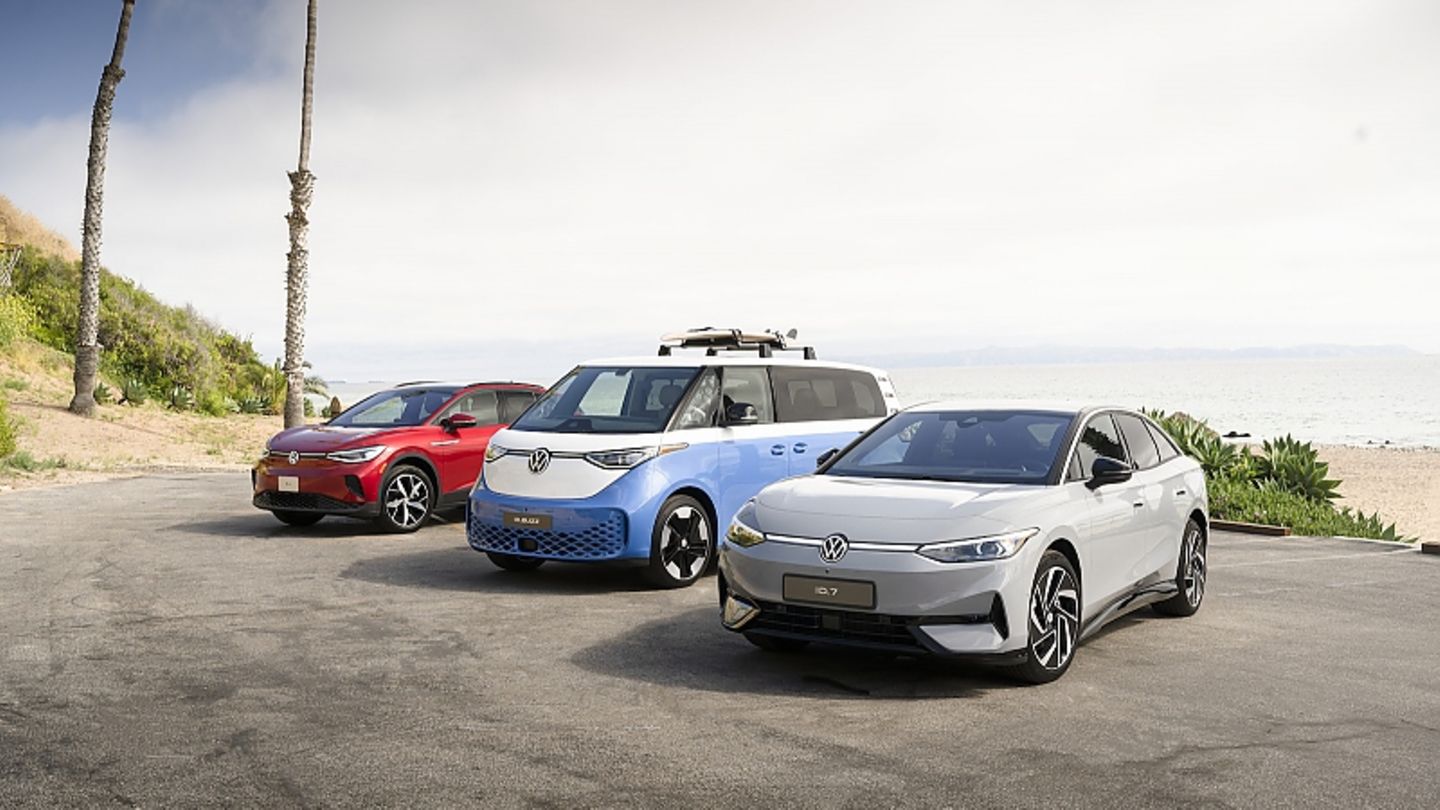In China and in Europe, Volkswagen has been a big player as a car manufacturer for decades. However, things are very different in the USA. That should change in the coming years. The VW ID Buzz should be the official starting signal for the big race to catch up.
Thomas Schäfer, CEO of Volkswagen and Pablo Di Si, President and CEO of Volkswagen Group of America, stand on the big show stage in Huntington Beach. The two of them just unveiled the new VW ID Buzz at the Bus Festival, which is due to be launched in North America as a long version at the beginning of next year. “The ID Buzz and the USA – they go together perfectly! The VW bus has a long history in the USA and enjoys real cult status,” says Pablo Di Si with his usual smile. “Our aim today is to further strengthen the Volkswagen brand in America. The large ID Buzz is exactly the right model for this.” The US version of the ID Buzz is 25 centimeters longer, significantly more powerful and also available as a seven-seater with all-wheel drive. Pablo Di Si wants to bring new customers to the brand from Wolfsburg, which has been struggling to be really successful in the United States for decades, not just because of the diesel affair. The Volkswagen brand group currently has a sales share of almost five percent in the USA. In the coming years, this should double to ten percent, in particular due to new electric models. This also applies to the pure VW market share, the target of which is five percent of the overall American market.
The trend reversal should bring the ID Buzz. Not that the long-awaited new edition of the VW Microbus would become a mass model in the land of unlimited automotive possibilities, but the electric bus could be worth its weight in gold for the image. For a long time there was a lack of the right Volkswagen products, the understanding of the US market, which ticks completely differently from that in Europe, although many products are similar. The Golf GTI is a scene athlete and the Jetta is a cheap entry-level model – that’s about it. With the switch to electromobility, Volkswagen now sees an opportunity for a new start, and that comes at just the right time in times of the Inflation Reduction Act proclaimed in 2022. “By the end of the decade, we want to see 55 percent of our new vehicles electrically powered,” Pablo di Si looks confidently ahead, “by 2035 we will be completely electric in the USA.” A clear statement that not many manufacturers in the USA currently dare to make , because the car market between Alaska and Florida, New York and San Diego is considered to be extremely inhomogeneous. While electric models are increasingly in demand in the coastal regions in the east and west, things are very different in the interior. For more than 40 years, the Ford F-Series with its powerful pick-ups has been the undisputed bestseller in the USA – not only thanks to the southern states and the Wheat Belt. After all, the Ford F-150 has also been available as an electric version for over a year.
Volkswagen has never really understood the North Americans’ love of large, full-size pickups. The few pickups with the VW logo were intended for the volume markets in Asia and South America. Most recently, the decision was made to develop and produce the VW Amarok together with Ford in South Africa. He’s not coming to the US. After much hesitation, there are other plans for the United States. From 2026, an electric pair consisting of a full-size SUV and a corresponding pick-up will be launched under the brand name Scout, which will appeal to completely new customer groups as opponents of the Ford F-150, Chevrolet Silverado and Ram 150. A smaller electric pick-up two classes below doesn’t seem to stand a chance in the medium term, but even with a VW signet in the radiator grille. However, this would probably have to be produced at the Chattanooga / Tennessee plant, where the ID4 has only recently rolled off the assembly line as the first electric model. Somewhat surprisingly, however, the ID Buzz with the production site in Hanover is a pure import model. Local US production would only be worthwhile if the quantities were around 100,000 vehicles per year, which is unlikely to happen with electric buses. With its cool design and two-tone paintwork, it is intended to provide image rather than volume. This is not least due to its handsome price, which should hardly start below 70,000 US dollars. The current average price of an electric model from the USA is less than 50,000 US dollars.
However, one danger is omnipresent, because no matter what the outcome of the US presidential election in autumn 2024, it is not unlikely that the United States will isolate itself economically in a similar way to China. Only vehicles that were also produced in the USA could then be sold successfully – including local components. There are already significant benefits if the electric cars are manufactured in the USA and battery packs are installed that come from North America. One reason why Volkswagen is planning a gigantic battery plant in Canada. In the medium term, it therefore seems quite possible that the plant in Chattanooga will be significantly expanded – also to offer any other group brands a second production home. Audi has been successfully building its Q5 in Mexico for several years; However, he is also interested in US production such as Cupra or Porsche. Linked to the platform, it would also be possible to find the necessary quantities across brands so that the necessary suppliers could also expand their capacities in the southern United States. In the next seven years, VW wants to present 25 new electric models in the USA.
However, nothing works on the US market without the right products, because American customers pay much more attention to money and product availability. What is bought is what is in the dealer’s yard, long warranty periods are just as common as products that meet needs, and local production would not only help here, but also strengthen the commitment to the USA. It’s no longer a secret that the next generation of the recently revised VW Atlas SUV will be an electric version. An electric sedan as a successor to the Passat or Jetta also seems more important than ever for the US market. Classic limousines play a significant role for volume and mass brands such as Honda, Toyota, Nissan and Chevrolet. In addition, Volkswagen does not want to let the pure electric manufacturer Tesla rush any further. In particular, the new VW ID7 should be positioned against him.
Source: Stern
I’m a recent graduate of the University of Missouri with a degree in journalism. I started working as a news reporter for 24 Hours World about two years ago, and I’ve been writing articles ever since. My main focus is automotive news, but I’ve also written about politics, lifestyle, and entertainment.




